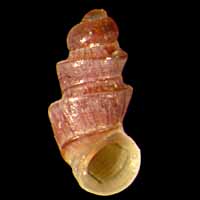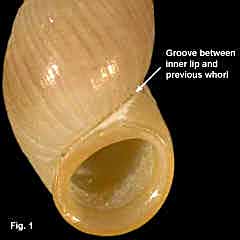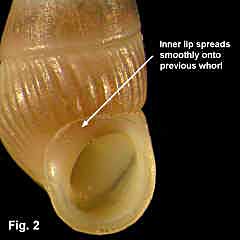|
< Previous family introduction |
|
|||||||
 |
Family Anabathridae
|
|||||||
|
The Anabathridae is a family of minute and small molluscs that are common or abundant intertidally in temperate Australia. The family is concentrated in two centres - temperate Australia and New Zealand, and the Caribbean and eastern Pacific coast of North America - with a few representatives in the tropical Indo-west Pacific and the Mediterranean. Previously, they were grouped in the Rissoidae, and more recently as a subfamily in the Barleeidae. In anatomical terms, the family is differentiated within the superfamily Rissooidea by having the penis innervated by the cerebral ganglia instead of by the pedal nerve. In shell terms, there are two characters that are important in recognising the family. (These are shared with the Barleeidae, but no species of that family is found in NSW). The protoconch is paucispiral, sculptured with spiral rows of minute pits, and the shell has a chitinous inner shell layer, giving the shell a reddish-brown colour. This chitinous layer can sometimes be seen in shells that have been drilled by a predator, where the drilled hole has failed to penetrate the inner layer. An important shell feature found in shells of the family (except for Pisinna) is that there is a cleft or groove between the inner lip of the aperture and the parietal wall of the preceding whorl (Fig. 1). Anabathrids occur mainly in the low intertidal and shallow subtidal, living on algae or under stones; a few species are commonly obtained from algal washings and in beach washup while the remainder are more spasmodic in occurrence. A smaller number of species occurs on the continental shelf, including the largest species of the family which reach up to about 6.5 mm! There are 29 species of the family recorded from NSW. These vary in size from 1 to 6.5 mm, in abundance from freuent to rare, and in habitat from the mid-intertidal to about 300 m deep. All are considered to be endemic to Australia. They have ranges typical of other molluscan families found in NSW; a few are restricted to the state borders, others are restricted to eastern Australia from southern Queensland southwards, and others have a wider southern Australian distribution, from NSW around southern Australia to south-western Western Australia, including Tasmania. These minute molluscs were named from 1865 onwards. The first group of the most common species was named by Frauenfeld, from specimens collected from around Sydney by the Novara Expedition in 1858. He was followed by the Rev. J.E. Tension-Woods in Tasmania in the 1860s, and then by late 19th and early 20th century workers - W.F. Petterd and then W.L. May in Tasmania, J.H. Gatliff and C.J. Gabriel in Victoria, John Brazier and then Charles Hedley in NSW. Following these workers, these was a gap until Charles Laseron commenced his work on minute molluscs in NSW, treating what is now recognised as the Anabathridae in his "Review of the Rissoidae of New South Wales" (Laseron, 1950). Laseron recognised many new species in that publication, some of which remain valid and some which have turned out to be synonyms of previously recognised species. Laseron's work was entirely overtaken by Ponder & Yoo (1976) who published a thorough account of the genus Pisinna, for the first time for the family working with anatomical and radular characters as well as shell morphology. Later, Ponder (1983) reviewed the genera of the Barleeidae, of which the subfamily Anabathrinae has since been raised to family level. Their accounts remains as the current statement on which the present tabulation is based. Family References These are the main references useful for species identification. Other references cited in the text are listed in References, accessible from the Table of Contents page.
Coverage All named species that occur in NSW are figured here. There are some further specimens in the Australian Museum collection that may be either undescribed species or range extensions of extra-limital species. Identification notes Shells of this family are characterised by:
|

